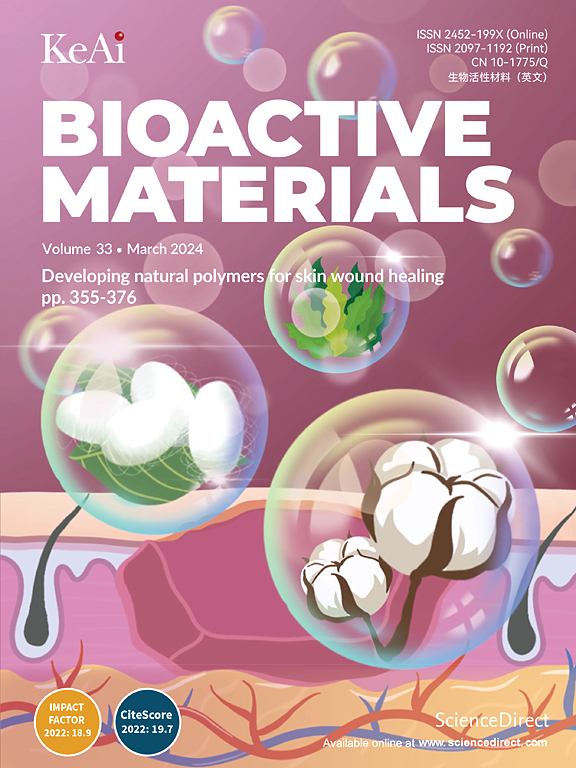MXenes as emerging materials to repair electroactive tissues and organs
IF 18
1区 医学
Q1 ENGINEERING, BIOMEDICAL
引用次数: 0
Abstract
Nanomaterials with electroactive properties have taken a big leap for tissue repair and regeneration due to their unique physiochemical properties and biocompatibility. MXenes, an emerging class of electroactive materials have generated considerable interest for their biomedical applications from bench to bedside. Recently, the application of these two-dimensional wonder materials have been extensively investigated in the areas of biosensors, bioimaging and repair of electroactive organs, owing to their outstanding electromechanical properties, photothermal capabilities, hydrophilicity, and flexibility. The currently available data reports that there is significant potential to employ MXene nanomaterials for repair, regeneration and functioning of electroactive tissues and organs such as brain, spinal cord, heart, bone, skeletal muscle and skin. The current review is the first report that compiles the most recent advances in the application of MXenes in bioelectronics and the development of biomimetic scaffolds for repair, regeneration and functioning of electroactive tissues and organs including heart, nervous system, skin, bone and skeletal muscle. The content in this article focuses on unique features of MXenes, synthesis process, with emphasis on MXene-based electroactive tissue engineering constructs, biosensors and wearable biointerfaces. Additionally, a section on the future of MXenes is presented with a focus on the clinical applications of MXenes.

MXenes作为修复电活性组织和器官的新兴材料
具有电活性的纳米材料以其独特的物理化学性质和生物相容性在组织修复和再生方面取得了巨大的飞跃。MXenes是一种新兴的电活性材料,其在生物医学上的应用已经引起了人们的极大兴趣。近年来,由于其优异的机电性能、光热性能、亲水性和柔韧性,这些二维神奇材料在生物传感器、生物成像和电活性器官修复等领域的应用得到了广泛的研究。目前可获得的数据表明,MXene纳米材料在电活性组织和器官(如脑、脊髓、心脏、骨骼、骨骼肌和皮肤)的修复、再生和功能方面具有巨大的潜力。本文首次综述了MXenes在生物电子学中的应用以及用于心脏、神经系统、皮肤、骨骼和骨骼肌等电活性组织和器官的修复、再生和功能的仿生支架的发展的最新进展。本文主要介绍了MXenes的特点、合成过程,重点介绍了基于MXenes的电活性组织工程构建、生物传感器和可穿戴生物接口。此外,还有一个关于MXenes未来的章节,重点介绍了MXenes的临床应用。
本文章由计算机程序翻译,如有差异,请以英文原文为准。
求助全文
约1分钟内获得全文
求助全文
来源期刊

Bioactive Materials
Biochemistry, Genetics and Molecular Biology-Biotechnology
CiteScore
28.00
自引率
6.30%
发文量
436
审稿时长
20 days
期刊介绍:
Bioactive Materials is a peer-reviewed research publication that focuses on advancements in bioactive materials. The journal accepts research papers, reviews, and rapid communications in the field of next-generation biomaterials that interact with cells, tissues, and organs in various living organisms.
The primary goal of Bioactive Materials is to promote the science and engineering of biomaterials that exhibit adaptiveness to the biological environment. These materials are specifically designed to stimulate or direct appropriate cell and tissue responses or regulate interactions with microorganisms.
The journal covers a wide range of bioactive materials, including those that are engineered or designed in terms of their physical form (e.g. particulate, fiber), topology (e.g. porosity, surface roughness), or dimensions (ranging from macro to nano-scales). Contributions are sought from the following categories of bioactive materials:
Bioactive metals and alloys
Bioactive inorganics: ceramics, glasses, and carbon-based materials
Bioactive polymers and gels
Bioactive materials derived from natural sources
Bioactive composites
These materials find applications in human and veterinary medicine, such as implants, tissue engineering scaffolds, cell/drug/gene carriers, as well as imaging and sensing devices.
 求助内容:
求助内容: 应助结果提醒方式:
应助结果提醒方式:


